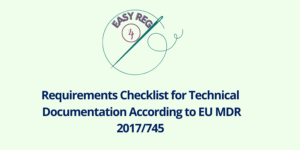Medical Device definition has been changed with the new EU MDR 2017/745 and the impact of this change over manufacturers of “borderline” devices is huge.
With QualityMedDev websites we have been extensively discussing about medical device regulation and quality management system requirements that may support manufacturers of medical products. We we know, we have been writing about many different topics, with a particular focus to the new EU MDR 2017/745 and IVDR 2017/746, giving particular attention to the new requirements introduced within these new regulations, such as for example in the fields post-market surveillance, PRRC, PSUR, GSPR, economic operators, etc.
However we have never been facing the topic related to the definition of medical device even if this is crucial: in fact, with the huge development of digital health technologies, many products remains at the interface between consumer and medical products. This point is of extremely importance as the market access from regulatory standpoint of a medical device is much more complicated and time consuming.
What is a Medical Device?
The definition of medical devices is reported within Article 2 of the EU MDR 2017/745:
medical device’ means any instrument, apparatus, appliance, software, implant, reagent, material or other article intended by the manufacturer to be used, alone or in combination, for human beings for one or more of the following specific medical purposes:
- diagnosis, prevention, monitoring, prediction, prognosis, treatment or alleviation of disease;
- diagnosis, monitoring, treatment, alleviation of, or compensation for, an injury or disability;
- investigation, replacement or modification of the anatomy or of a physiological or pathological process or state;
- providing information by means of in vitro examination of specimens derived from the human body, including organ, blood and tissue donations;
and which does not achieve its principal intended action by pharmacological, immunological or metabolic means, in or on the human body, but which may be assisted in its function by such means.
If we compared this definition with the previous definition of medical device reported in the Medical Device Directive 94/42/EEC, the new definition includes more options that will end up in the inclusion of more family of products into the medical device definition.
In fact, some products that were previously not regarded as medical devices became medical devices according to the new definition mentioned in EU Medical Device Regulation EU MDR 2017/745.
For example, devices for the support of conception: in the previous Medical device Directive, the control of conception was part of the definition but not the support of conception.
In any case, when evaluating if a product shall be considered a medical device or not, the main element that shall be considered is the intended use of the device. In fact, if the intended use has a specific medical application, then the product is obviously a Medical Device.
Product without Intended Medical Purpose
The EU MDR 2017/745 has included a list of products without an intended medical purpose in Annex XVI of the regulation. These devices, although they should not considered medical devices, have similar functions and risk profile to medical device. Thus, to introduce the devices mentioned in Annex XVI in the EU market, MDR requirements, including clinical evaluation and post-market surveillance, need to be properly fulfilled.
We will discuss about these types of devices in a different article.
Medical Devices that are also Machines
The machines are covered by the Directive 2006/42/EC concerning devices incorporating an energy source and moving parts. This for example involves robotic devices used in surgery or other type of similar solutions.
Where there is a particular hazard the Annex I of the Machinery Directive must be complied with in addition to the requirements of the regulation. They are considered more suitable for making the product safe to use.
In fact, article 1 of EU MDR clearly states:
“Devices that are also machinery within the meaning of point (a) of the second paragraph of Article 2 of Directive 2006/42/EC of the European Parliament and of the Council (35) shall, where a hazard relevant under that Directive exists, also meet the essential health and safety requirements set out in Annex I to that Directive to the extent to which those requirements are more specific than the general safety and performance requirements set out in Chapter II of Annex I to this Regulation.”
In summary, the machine directive is applicable to medical device when the following three conditions are met:
- The device is machinery according to Art. 2(2)(a) of the Machinery Directive;
- A relevant hazard under the machinery directive may occur;
- The Essential Health and Safety Requirements of the Machinery Directive contain more specific requirements than the general safety and performance requirements of the MDR.
For all these reasons, it is always very important to take inconsideration the definition of medical device and properly evaluate the application of additional requirements, even if the device fully applies to the EU MDR.
Subscribe to 4EasyReg Newsletter
4EasyReg is an online platform dedicated to Quality & Regulatory matters within the medical device industry. Have a look to all the services that we provide: we are very transparent in the pricing associated to these consulting services.
Within our WebShop, a wide range of procedures, templates, checklists are available, all of them focused on regulatory topics for medical device compliance to applicable regulations. Within the webshop, a dedicated section related to cybersecurity and compliance to ISO 27001 for medical device organizations is also present.
As one of the leading online platforms in the medical device sector, 4EasyReg offers extensive support for regulatory compliance. Our services cover a wide range of topics, from EU MDR & IVDR to ISO 13485, encompassing risk management, biocompatibility, usability, software verification and validation, and assistance in preparing technical documentation for MDR compliance.
Do not hesitate to subscribe to our Newsletter!

